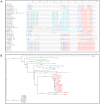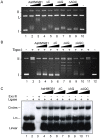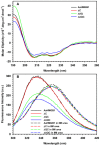The dengue vector Aedes aegypti contains a functional high mobility group box 1 (HMGB1) protein with a unique regulatory C-terminus
- PMID: 22802955
- PMCID: PMC3388995
- DOI: 10.1371/journal.pone.0040192
The dengue vector Aedes aegypti contains a functional high mobility group box 1 (HMGB1) protein with a unique regulatory C-terminus
Abstract
The mosquito Aedes aegypti can spread the dengue, chikungunya and yellow fever viruses. Thus, the search for key molecules involved in the mosquito survival represents today a promising vector control strategy. High Mobility Group Box (HMGB) proteins are essential nuclear factors that maintain the high-order structure of chromatin, keeping eukaryotic cells viable. Outside the nucleus, secreted HMGB proteins could alert the innate immune system to foreign antigens and trigger the initiation of host defenses. In this work, we cloned and functionally characterized the HMGB1 protein from Aedes aegypti (AaHMGB1). The AaHMGB1 protein typically consists of two HMG-box DNA binding domains and an acidic C-terminus. Interestingly, AaHMGB1 contains a unique alanine/glutamine-rich (AQ-rich) C-terminal region that seems to be exclusive of dipteran HMGB proteins. AaHMGB1 is localized to the cell nucleus, mainly associated with heterochromatin. Circular dichroism analyses of AaHMGB1 or the C-terminal truncated proteins revealed α-helical structures. We showed that AaHMGB1 can effectively bind and change the topology of DNA, and that the AQ-rich and the C-terminal acidic regions can modulate its ability to promote DNA supercoiling, as well as its preference to bind supercoiled DNA. AaHMGB1 is phosphorylated by PKA and PKC, but not by CK2. Importantly, phosphorylation of AaHMGB1 by PKA or PKC completely abolishes its DNA bending activity. Thus, our study shows that a functional HMGB1 protein occurs in Aedes aegypt and we provide the first description of a HMGB1 protein containing an AQ-rich regulatory C-terminus.
Conflict of interest statement
Figures








Similar articles
-
Molecular and functional characterization of single-box high-mobility group B (HMGB) chromosomal protein from Aedes aegypti.Gene. 2018 Sep 10;671:152-160. doi: 10.1016/j.gene.2018.05.103. Epub 2018 May 31. Gene. 2018. PMID: 29859286
-
The DNA chaperone HMGB1 potentiates the transcriptional activity of Rel1A in the mosquito Aedes aegypti.Insect Biochem Mol Biol. 2017 Jan;80:32-41. doi: 10.1016/j.ibmb.2016.11.006. Epub 2016 Nov 17. Insect Biochem Mol Biol. 2017. PMID: 27867076
-
Interactions of the basic N-terminal and the acidic C-terminal domains of the maize chromosomal HMGB1 protein.Biochemistry. 2004 Jun 29;43(25):8029-37. doi: 10.1021/bi0499009. Biochemistry. 2004. PMID: 15209498
-
Interactions of high mobility group box protein 1 (HMGB1) with nucleic acids: Implications in DNA repair and immune responses.DNA Repair (Amst). 2019 Nov;83:102701. doi: 10.1016/j.dnarep.2019.102701. Epub 2019 Sep 16. DNA Repair (Amst). 2019. PMID: 31563843 Free PMC article. Review.
-
HMGB proteins: interactions with DNA and chromatin.Biochim Biophys Acta. 2010 Jan-Feb;1799(1-2):101-13. doi: 10.1016/j.bbagrm.2009.09.008. Biochim Biophys Acta. 2010. PMID: 20123072 Review.
Cited by
-
Spätzle processing enzyme is required to activate dorsal switch protein 1 induced Toll immune signalling pathway in Tenebrio molitor.PLoS One. 2023 Sep 21;18(9):e0291976. doi: 10.1371/journal.pone.0291976. eCollection 2023. PLoS One. 2023. PMID: 37733725 Free PMC article.
-
Internal Associations of the Acidic Region of Upstream Binding Factor Control Its Nucleolar Localization.Mol Cell Biol. 2017 Oct 27;37(22):e00218-17. doi: 10.1128/MCB.00218-17. Print 2017 Nov 15. Mol Cell Biol. 2017. PMID: 28874518 Free PMC article.
-
PKA regulates HMGB1 through activation of IGFBP-3 and SIRT1 in human retinal endothelial cells cultured in high glucose.Inflamm Res. 2018 Dec;67(11-12):1013-1019. doi: 10.1007/s00011-018-1196-x. Epub 2018 Oct 17. Inflamm Res. 2018. PMID: 30328477 Free PMC article.
-
HMGB1 in health and disease.Mol Aspects Med. 2014 Dec;40:1-116. doi: 10.1016/j.mam.2014.05.001. Epub 2014 Jul 8. Mol Aspects Med. 2014. PMID: 25010388 Free PMC article. Review.
-
Zika virus infection drives epigenetic modulation of immunity by the histone acetyltransferase CBP of Aedes aegypti.PLoS Negl Trop Dis. 2022 Jun 27;16(6):e0010559. doi: 10.1371/journal.pntd.0010559. eCollection 2022 Jun. PLoS Negl Trop Dis. 2022. PMID: 35759510 Free PMC article.
References
-
- Li B, Carey M, Workman JL. The role of chromatin during transcription. Cell. 2007;128:707–719. - PubMed
-
- Groth A, Rocha W, Verreault A, Almouzni G. Chromatin challenges during DNA replication and repair. Cell. 2007;128:721–733. - PubMed
-
- Thomas JO, Travers AA. HMG1 and 2, and related ‘architectural’ DNA-binding proteins. Trends Biochem Sci. 2001;26:167–174. - PubMed
-
- Stros M. HMGB proteins: interactions with DNA and chromatin. Biochim Biophys Acta. 2010;1799:101–113. - PubMed
Publication types
MeSH terms
Substances
LinkOut - more resources
Full Text Sources

